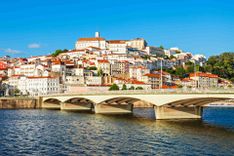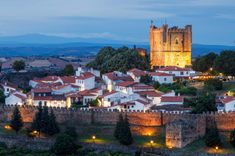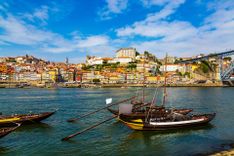Planning your own trip? Prepare for your trip
Use Rough Guides' trusted partners for great rates
- Portugal
- Faro
Plan and book your private, tailor-made tour with vetted local experts
If you travel to Portugal via the Algarve, there’s a good chance you’ll pass through Faro. With its international airport, massive shopping center, and ring of high-rise apartments, the city has a bit of a big-city buzz.
That said, the old town’s compact and easy to explore – think mosaic-paved pedestrian streets and marinaside gardens. Thanks to the local university, there’s also a solid nightlife scene, especially during term time.
In summer, boats and buses run from the centre of town out to some excellent local beaches: the closest to town is the generous swathe of sand at Praia de Faro, while a ferry makes the short hop to the village of Farol on the Ilha de Culatra.

Hi! I’m Luis, your Portugal travel expert to Faro, the sunny capital of the Algarve and one of the country’s most underrated city breaks. I’ll show you how to get here, what’s worth your time, where to base yourself, and the local hacks that make exploring easy.
If your trip to Portugal takes you through the south, don’t skip Faro; its cobbled old town, island beaches, and lagoon sunsets are far better than its “gateway airport” reputation suggests. Give it a day or two, and you’ll see why locals linger over coffee here instead of rushing to the resorts.
Luis's tip
Faro’s old town is compact, so skip the car while you are here, as parking is a headache. For the beaches, take the ferry from Porta Nova to Ilha de Faro or Ilha Deserta. If you plan to visit the islands in high summer, book your ferry tickets online a day ahead. Bring sunscreen and water because shade is minimal once you are out on the sandbanks.
Best time to visit
Late spring from April to May and early autumn from September to October bring warm days and light breezes with fewer crowds on the ferries. July and August are hot and busy, so expect queues for island boats and little shade in the old town. Winter is mild with some sunny days perfect for walking the lagoon trails, but many island cafés close for the season.
How to get to Faro
From Lisbon, direct trains reach Faro in about three and a half hours. Seats sell out on summer weekends, so booking ahead is wise. The airport is about 15 minutes from the city center by taxi or bus. Driving down the A2 motorway is straightforward, but once in Faro, park your car and explore on foot or by ferry. The city itself does not require a vehicle.
Best areas to stay in Faro
Faro lies on Portugal’s southern coast, at the edge of the Ria Formosa lagoon in the Algarve region. It is about 280km south of Lisbon and sits just east of some of the best beaches in the Algarve.
Often overlooked in favor of the larger resort towns, Faro deserves a spot among the best places to visit in Portugal. The city is perfectly situated for exploring the barrier islands of the Ria Formosa Natural Park, with ferries to Ilha Deserta, Ilha de Faro, and Ilha da Culatra departing directly from the marina. Inland, you can visit the whitewashed town of Estoi with its Roman ruins, or head west to coastal hubs like Albufeira and Lagos. To the east, the quieter sands of Tavira and Cacela Velha are within easy reach.
















Faro’s city center is small and flat, making it easy to explore on foot. Most hotels, restaurants, and bars are within a short walk of each other. For the beaches and islands, you will need to use a ferry, bus, or taxi, while the airport is just a short ride from town.

Faro with Se Cathedral © Shutterstock
To make the most of your visit to Faro, it is recommended to spend at least three to five days in the city. This duration allows you to explore the historic center, visit cultural attractions such as the Faro Cathedral and Municipal Museum, and experience the local beaches.
It also fits neatly into a Portugal itinerary by giving you time for excursions to the Ria Formosa Natural Park, where you can enjoy boat tours, island hopping, and discover the region’s coastal highlights.

Igreja do Carmo in the old town of Faro © Shutterstock
Accommodation in Faro ranges from boutique hotels in centuries-old buildings to modern stays by the water. Staying in the historic center puts you steps from cafés, shops, and the marina, while a beach base means waking up to the sound of waves.

Historic place in Milreu, near Faro, Portugal © Shutterstock
From glorious sweeps of golden sand to wandering around the historic Cidade Velha, these are the best things to do in Faro.
The Cidade Velha, or Vila-Adentro, is Faro’s most atmospheric quarter and the only part of the city to survive its long history of raids, sieges, and earthquakes. Enclosed by thick medieval walls, it feels quieter than the rest of the city, especially in the late afternoon when tour groups vanish and the streets fall into shadow. Here, whitewashed houses wear balconies of curling ironwork and tiles patterned in deep blues and greens. A few façades still bear marks from past cannon fire.
Enter through the Arco da Vila, an eighteenth-century gateway built over a medieval arch, and follow Rua do Município to the orange-tree-lined Largo da Sé. This square, framed by the cathedral and former bishops’ palace, is the best spot to pause with a coffee and simply watch the rhythm of Faro slow to a whisper.
Faro’s Sé has been rebuilt so many times that it is almost a palimpsest of the Algarve’s history. First raised in 1251 on the site of a mosque, it became the region’s main cathedral in 1577. Less than two decades later, English forces under the Earl of Essex looted it, taking treasures back to London. The earthquake of 1755 then shattered much of the structure, and the reconstruction that followed gave it today’s blend of Gothic, Renaissance, and Baroque styles.
Step inside for the cool hush of its tiled chapels, where eighteenth-century azulejos depict saints and floral motifs, and gilt woodwork glows in the half-light. The climb up the bell tower is steep, but the reward is a sweeping view that stretches from the terracotta rooftops of the old town to the shifting channels and sandbanks of the Ria Formosa: a reminder that this cathedral has always watched over a city shaped by both land and sea.
Faro’s Museu Municipal is one of the oldest museums in Portugal, founded in 1894 as an archaeological collection and still a treasure trove for history buffs. It occupies the quiet cloisters of the sixteenth-century Convento de Nossa Senhora da Assunção, a Renaissance building whose white arcades frame a serene courtyard. Its star exhibit is a remarkably well-preserved Roman mosaic, almost nine meters across, depicting Neptune surrounded by the Four Seasons. Dating from the third century, it was unearthed near the train station and is displayed in near-perfect condition.
The galleries also hold marble statues from the Roman villa at Milreu, delicate Moorish ceramics, and religious art from the Baroque and Renaissance periods. A small but fascinating section is dedicated to the Futurist paintings of Carlos Porfírio, a Faro-born artist who helped shape modern Portuguese art in the twentieth century. Out front, a statue of King Afonso III, the conqueror who claimed the Algarve in 1249, stands watch with a cross held high.
The Museu Regional may be small, but it offers a window into the Algarve before the arrival of package holidays and beach resorts. This unpretentious collection focuses on everyday life, with displays of traditional farming tools, hand-carved fishing gear, and musical instruments once played at village festivals. Room sets recreate the interiors of rural homes, complete with heavy wooden furniture, embroidered linens, and the faint suggestion of woodsmoke.
One corner holds model fishing boats built to scale, each painted in the bright colors typical of Algarve ports. The real gems are the black-and-white photographs, which capture Faro’s streets, islands, and beaches in the decades before tourism transformed them. On a rainy day, it is the kind of place where you can slow down, wander at your own pace, and picture the Algarve as locals once knew it.
The Baroque Igreja do Carmo, with its twin bell towers and gilded interior, is one of Faro’s most striking churches, even if it stands in an otherwise unremarkable part of town. Built in the early eighteenth century by the Carmelite order, it is a showcase of ornate woodcarving and gold leaf, much of it financed through wealth brought back from Brazil.
Tucked away in the overgrown garden behind the church is the Capela dos Ossos, the Chapel of Bones. Here, the walls are lined from floor to ceiling with the bones and skulls of more than a thousand Carmelite monks, exhumed from the adjoining cemetery. They are set into the plaster in careful geometric patterns, a stark reminder of mortality and the fleeting nature of worldly beauty. It is quiet inside, almost unnervingly so, and stepping back out into the sunlight can feel like waking from a vivid dream.

Praia De Faro, Algarve, Portugal © Shutterstock
The Igreja de São Pedro began as a humble fishermen’s chapel in the late sixteenth century, a place where sailors prayed for safe passage before heading to sea. Much of what you see today is the result of rebuilding after the devastating earthquake of 1755, which gave the church its more elaborate Baroque touches. Inside, sunlight filters through small windows, catching on the gold leaf and painted woodwork.
The highlight is to the left of the main altar: a carved and gilded relief of the Last Supper, its figures rendered in striking detail, each expression frozen mid-conversation. The church still serves an active parish, so you may hear the low murmur of prayers or the rustle of hymnbooks during your visit, adding to its sense of continuity with Faro’s seafaring past.
Praia de Faro, the city’s closest stretch of sand, sits on the Ilha de Faro and is the only beach here connected to the mainland by a bridge. This long ribbon of golden sand has two distinct sides: the open Atlantic, with steady waves and salty breezes, and the calmer lagoon-facing shore that looks over the Ria Formosa.
In summer, it can be busy, with beach bars, seafood restaurants, and holiday villas lining the narrow strip, yet walk a little farther from the bridge and you can still find quiet space. Out of season, it feels almost deserted, a peaceful reminder of why it ranks among the best beaches in Portugal. Its location just southwest of town, close to the airport, makes it an easy escape for a few hours or a full day in the sun.
Just outside the elegant village of Estói, the Roman site of Milreu is the Algarve’s most important Roman excavation and one of the few places where you can trace nearly two millennia of history in a single walk. The remains belong to a grand villa inhabited from the first century AD, built around a peristyle courtyard lined with columns and once decorated with vivid mosaics. In the sixth century, part of the complex was transformed into one of Portugal’s earliest Christian churches, repurposing the original Roman temple walls.
To the southwest lies a remarkably well-preserved bathing complex, complete with an underfloor heating system and walls adorned with fish-themed mosaics that shimmer in the sunlight. The apodyterium, or changing room, still has arched niches where bathers would have stored their clothes. A small visitor centre helps bring the site to life with reconstructions of the villa in its prime, when wealthy landowners looked out over fertile fields that are still farmed today.

Arco da Vila gateway leading to old town of Faro © Shutterstock
From the jetty just below Faro’s old town walls, boats set out into the channels of the Ria Formosa, a maze of tidal flats, salt marshes, and shifting sandbanks. The most popular trip is to Ilha Deserta, also known as Ilha da Barreta, the southernmost point of mainland Portugal. Here, there are no shops, no traffic, and only one café, which can be pricey but is handy for a cold drink in the heat.
The real draw is the beach: a wild, windswept stretch of sand where you can walk for more than seven kilometres without seeing a single building. The water is clear, the birdlife abundant, and the sense of isolation addictive. It is the kind of place where you quickly lose track of time, lulled by the sound of the surf and the calls of seabirds.
The Ria Formosa is one of the Algarve’s most rewarding places for outdoor activities, offering both adventure and wildlife in a single setting. Its calm lagoon waters are ideal for kayaking or stand-up paddleboarding, and you can explore winding channels that lead to deserted sandbanks and quiet coves. Sailing is another option, with the breeze carrying you past oyster beds and fishing huts on stilts.
For nature lovers, the park is a birdwatching hotspot, especially in spring and autumn when flamingos, spoonbills, and ospreys migrate through. Walking and cycling trails follow the lagoon’s edge, giving you a slower, more immersive way to experience this protected landscape.

Fisherboats at the beach Natural Park Ria Formosa - Algarve - Portugal © Michael Schroeder/Shutterstock
Faro enjoys a Mediterranean climate, with hot, dry summers and mild winters, plus plenty of sunshine year-round. Thanks to its coastal position in the Algarve, sea breezes keep peak summer heat more bearable than inland areas, though shade can be scarce on the beaches. Average highs range from 61°F (16°C) in January to 84°F (29°C) in August. Many travelers consider late spring or early autumn the best time to visit Portugal, as Faro offers warm weather, fewer crowds, and easy access to the islands and beaches. For current conditions, check the IPMA (Portuguese Institute for Sea and Atmosphere).

Saint Peter Church, or Igreja de São Pedro, a baroque church of southern Portugal in Faro, Algarve © Shutterstock
Faro’s dining scene blends traditional Algarve flavors with modern touches, from no-frills tascas serving grilled sardines to waterfront restaurants where you can linger over fresh seafood while watching the sun dip behind the marina. You will also find pastelarias (pastry cafés) perfect for a morning coffee before heading to the islands.

Farol island in Formosa Estuary, Algarve, Portugal © Shutterstock
Here are some unique experiences you can add to a Faro trip, all private, flexible, and arranged by local guides who know the region inside out.
Discover Portugal's most captivating stories
Use Rough Guides' trusted partners for great rates
written by
Olga Sitnitsa
Online editor at Rough Guides, specialising in travel content. Passionate about creating compelling stories and inspiring others to explore the world.